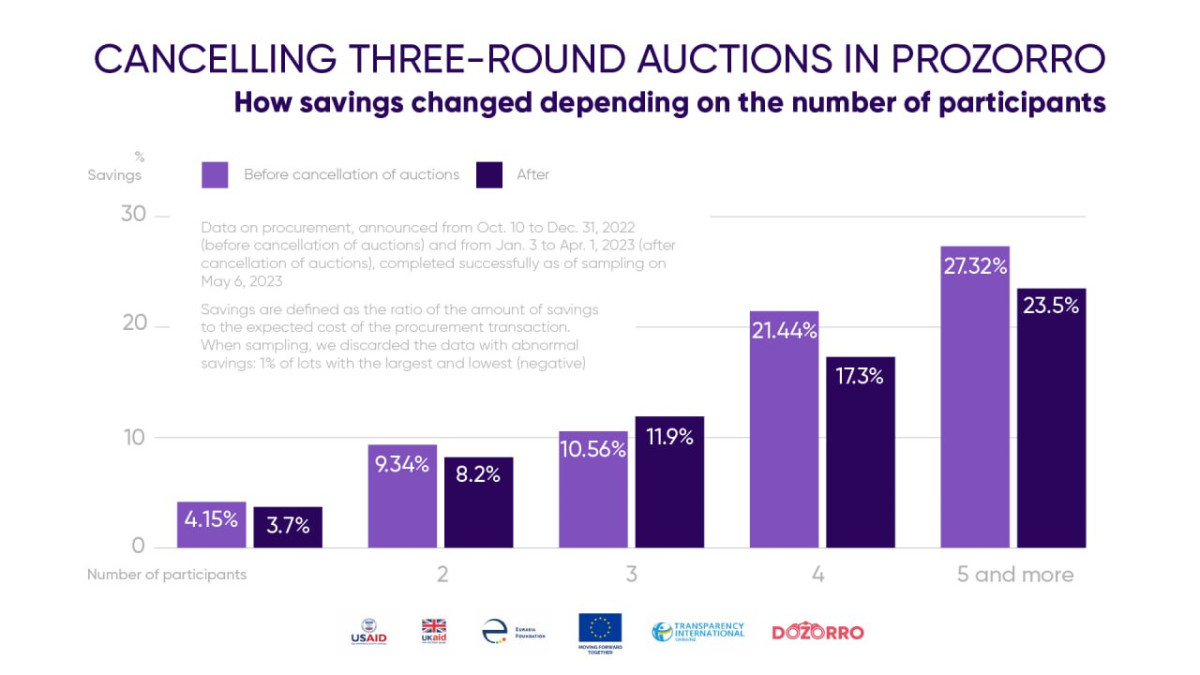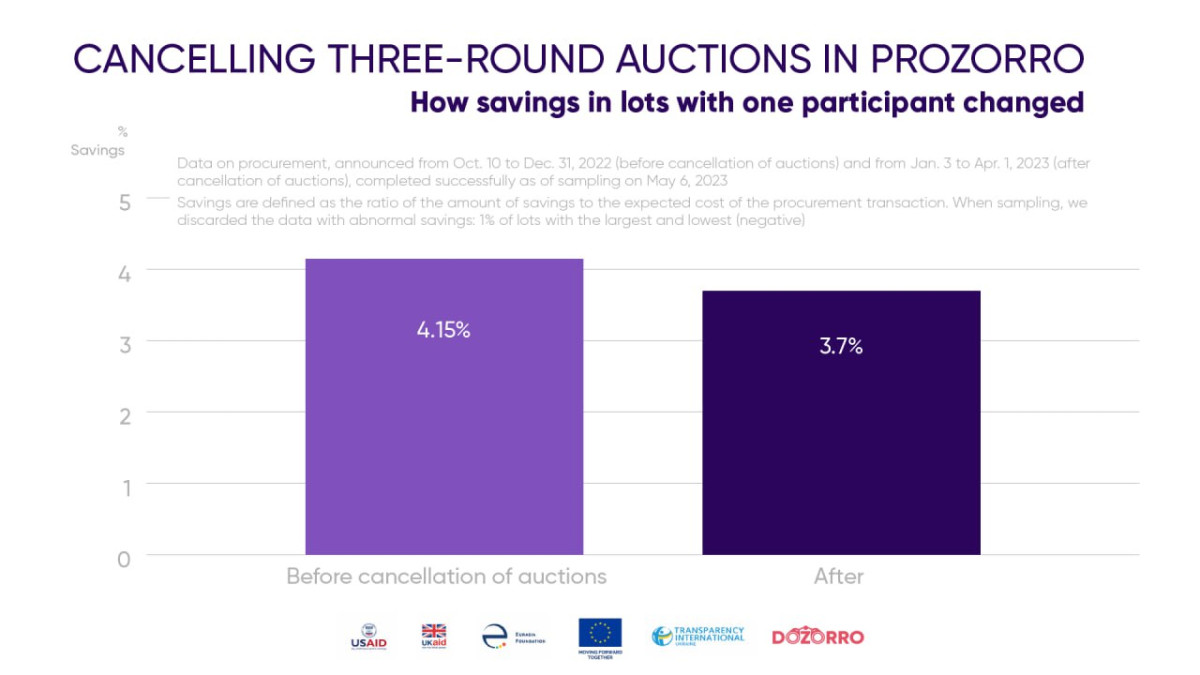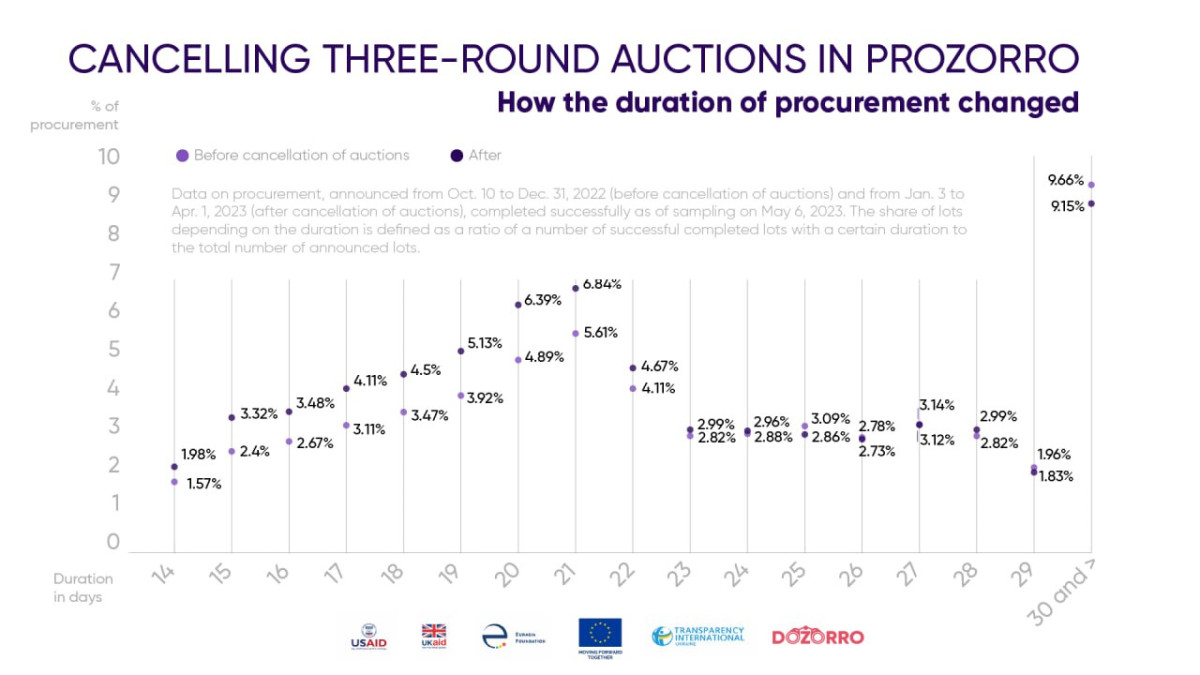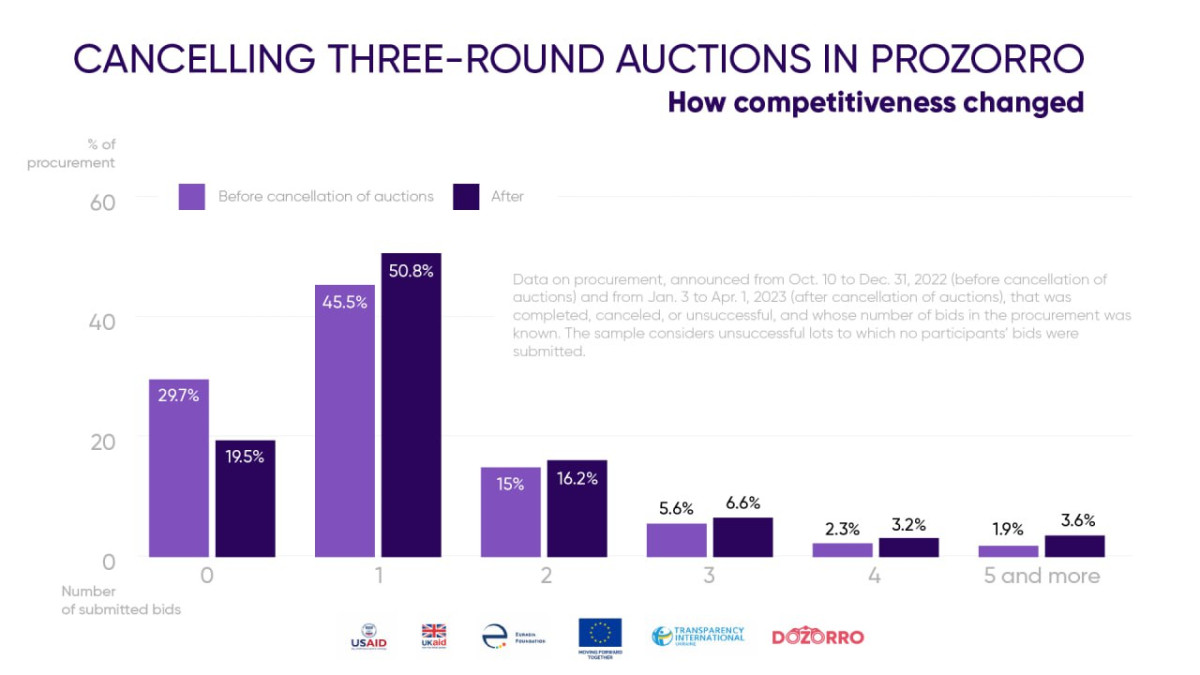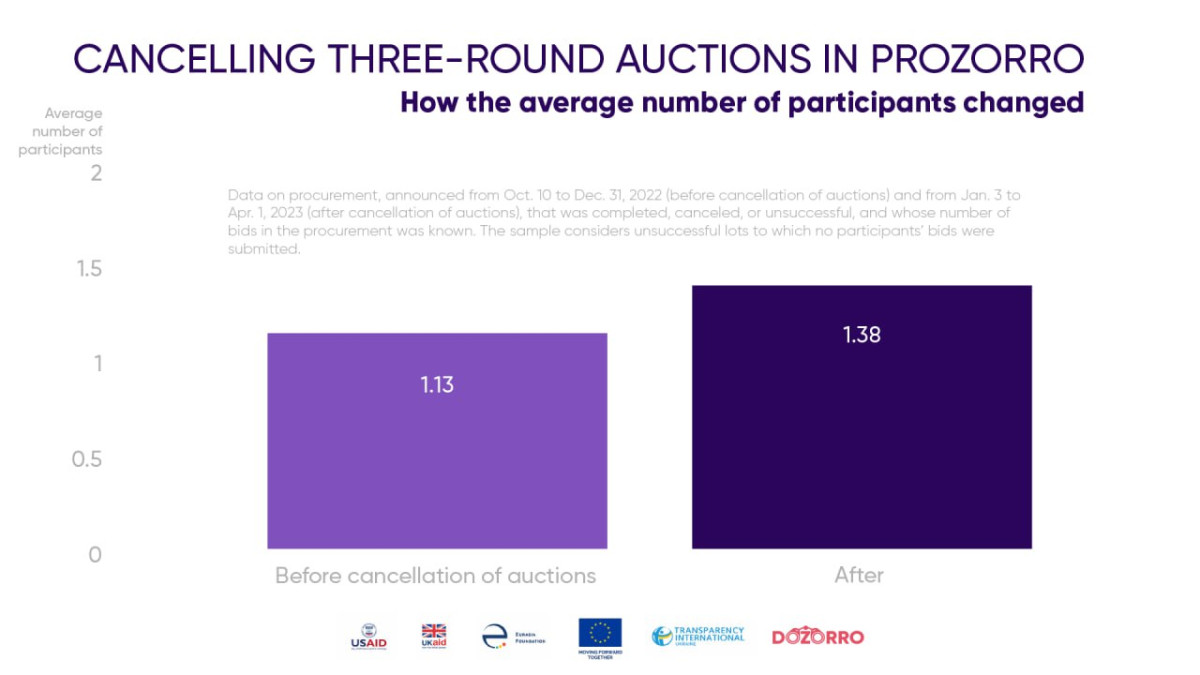

The Cabinet of Ministers restores three-round auctions in Prozorro; at the beginning of the year, they were temporarily replaced by a blind auction. Within the latter, participants cannot reduce the price, the winner is chosen immediately based on the initial price proposals.
However, this is not a complete return to the previous approach because now, procuring entities have the right to conduct procurement in the same way without reducing the price if they justify the need for it. The Ministry of Economy explains this optionality by the fact that in the future, they would like to provide an opportunity to flexibly respond to the situation with energy supply or other force majeure events that may be caused by war. However, in January, the introduction of such a mechanism caused quite a heated discussion about the feasibility and effectiveness of such a step.
In particular, Transparency International Ukraine warned that it was not sufficiently justified and contained some risks. The auction is a guarantee of active competition of participants and allows achieving maximum savings. Abandoning it can potentially reduce the savings on procurement, which is unacceptable during the war and with limited funding.
Those who were neutral or positive about such an idea said that procurement without an auction was widely applied in the West, and it had its advantages.
Many studies are devoted to the question of the advantages of tenders with and without auctions, but most of them are quite theoretical. After all, these approaches are difficult to compare in terms of their effectiveness in laboratory conditions. After the cancellation of auctions, Ukraine was able to determine the practical effect of different approaches to procurement.
Bidding with and without an auction: the main differences
The main difficulty in comparing various procurement methods is that the logic of the participant’s behavior in them is fundamentally different.
In bidding with a multi-round auction, the participant can submit an initial bid close to the expected value and continue to build their strategy already depending on how the auction will go. If the activity of competitors is low, they can win with a high price. If the activity is high — the participant will have to lower their bid or lose.
However, to say that the participant is interested in giving the highest possible starting price is also wrong. After all, the size of the initial proposal determines the sequence of steps of participants in the auction. The one who gave the lowest price has an advantage over competitors — taking the step last.
Procurement with a blind auction implies that participants have only one attempt to submit their proposal and get it right. If the price is too low, the entrepreneur will receive less profit than they could have. If it is too high, they can lose the tender to a competitor. This seems to stimulate them to provide a lower proposal from the start.
Research on the practice of applying auctions comes to the conclusion that procurement with multi-round auctions is more priority if the procurement item is sufficiently competitive and there are three or more bids on the market that meet the requirements of the procuring entity.
For procurement in a market with low competition and a limited range of potential suppliers, a one-round auction can produce a better effect. Moreover, this method is faster and can be used for less important categories of procurement.
In many countries, the procuring entity themselves can determine whether to apply a multi-round auction or not in specific cases. This approach is called an optional auction.
There are also some transitional procurement models, in which the auction is appointed after the submission of bids by the participants if there are at least three of them, or when the difference between the lowest starting bid and the next one is less than 10%. Such intermediate rules theoretically have the advantages of both approaches: the participant does not know whether their initial bid is final, and if the bidding is competitive, the auction allows for maximum savings. But so far, such methods of procurement are not very popular due to the complexity of technical implementation. And their advantages are mostly theoretical, they are difficult to test.
Hypothesis testing
We put forward a number of different hypotheses based on theoretical studies of the effectiveness of procurement with and without an auction.
Two periods were chosen for comparison:
- from October 19 to December 31, 2022;
- and after cancellation — from January 3 to April 1, 2023.
Of course, this is not a perfect sample, as one period was at the end of the budget year and the other at the beginning. Moreover, during these periods, there were different conditions with the supply of electricity, which could affect the course of procurement, in particular, the prices of the participants. However, back then, approximately the same rules were in force, and the main difference was precisely the presence/absence of a mandatory auction.
We downloaded the sample on May 5. It included only successfully completed lots as of that date. Savings in calculations are defined as the ratio of the amount of savings to the expected cost of the procurement transaction. We also discarded the data with abnormal savings from the sample: 1% of lots with the largest and lowest (negative) savings.
1. Cancellation of multi-round auctions will reduce savings
The main advantage of procurement with auctions is the possibility to achieve better economic efficiency of procurement. This statement is cited by most studies on the practice of using auctions. Theoretically, the effect of the auction reaches the optimal value when three or more participants take part in the procurement transaction.
A comparison of procurement transactions before and after the cancellation of auctions generally confirms this hypothesis.
During the period under review, prior to the cancellation of auctions, lots worth almost UAH 95 bln were successfully completed. The amount of savings is UAH 7.63 bln. That is, the savings in these tenders amounted to 8.03% of the expected value.
After the cancellation of auctions, lots worth more than UAH 88 bln were successfully completed. The amount of savings in them is only UAH 6.06 bln. Thus, the share of savings in the completed bidding decreased from 8.03% to 6.83% — by 1.2%.
If you look at procurement in terms of the number of participants, the difference in savings between bidding with and without an auction is minimal in procedures with 1–3 participants and grows significantly with the increase in the number of participants. In tenders where 4-5 or more participants took part, the difference in the savings indicator is already 3-4%, depending on whether the auction was applied or not.
At the same time, bidding without an auction gives an even better indicator of savings in lots with an expected cost of less than UAH 200,000. If we analyze the percentage of savings in different ranges of the amounts of expected value, it turns out that in the smallest tenders after the cancellation of the auction, the indicator of savings even increased. Obviously, the rule of the change in the behavior of the participant really works here. In small tenders, there is a high probability that competition will be low, and therefore the “blind auction” encourages the participant to give a slightly lower price than in lots with an auction. But with the increase in the expected cost of procurement, the advantage of bidding with an auction increases. In tenders, worth from UAH 200,000 to UAH 500,000, tenders with and without an auction showed almost the same result. And in the bidding for the amount more than UAH 1 mln, the auction provides much bigger savings. Since it is these tenders that form the majority of the savings in the Prozorro system, this is reflected in the overall result, which is provided below (an overall savings reduction by 1.2%).
Considering this, it can be concluded that in general, the cancellation of the auction affected the savings of tenders in the system. This is especially true for expensive procurement. Potentially, this 1% reduction in savings is a loss of more than a billion hryvnias in savings for only three months under study.
However, in tenders with an expected cost of less than UAH 200,000, after the auction was canceled, the savings indicator even improved. Accordingly, for procurement with a lower expected cost, several options can be considered:
- to keep blind auctions;
- to implement optional ones: so that the procuring entity decides to buy with an auction or without it;
- or raise the threshold altogether (but this issue needs additional study).
For procurement of more than UAH 500,000, it is advisable to apply a mandatory three-round auction.
2. Bidding without an auction will produce higher savings in procurement with a minimum number of participants
Before switching to a blind auction, 65% of open tenders with features that had enough bids were held with one participant. In such cases, a three-round auction did not take place and the participant’s initial bid became final. Since the participant could previously reduce their price during the auction, a more winning strategy was to put a higher bid and lower it if you have competitors. Accordingly, if only one participant took part in the tender, this increased the risk that the procuring entity would receive a higher price than the one that the entrepreneur was actually ready to give (if they had competitors).
In a blind auction, participants cannot reduce their bids after they see the bids of competitors. In theory, this was to encourage them to provide lower prices at once to increase their chance of winning.
The practice of applying bidding without an auction in Prozorro does not confirm this hypothesis.
If we compare procurement before and after the cancellation of auctions, the indicator of the amount of savings in tenders with one participant has not changed.
Prior to the cancellation of auctions, successful competitive tenders with one participant were announced for UAH 52.1 bln. The amount of savings in them was UAH 2.15 bln. After the cancellation of auctions, the amount of such bidding is UAH 53 bln, and the amount of savings is UAH 1.96 bln.
In percentage terms, the savings rate even decreased — from 4.15% to 3.7%.
Consequently, the cancellation of the auction did not contribute to a decrease in the cost of bids in the bidding with one participant (with low competitive activity). The hypothesis that in auction, participants can give a higher starting bid, leaving a margin for bidding, does not find confirmation in the analysis results.
Obviously, this is due to the fact that participants tend to predict low competition only in small tenders. If the expected value increases, the presence or absence of an auction significantly affects the strategy for determining the initial cost.
3. Cancellation of auctions will reduce the time of procurement
The cancellation of the three-round auction deprived the procurement of two stages that influenced its duration:
- waiting for the auction: after the end of the period of bid submission, the auction does not take place immediately, but on the day and time appointed by the system;
- the actual stage of the auction, where participants can alternately reduce their prices.
Thus, the average duration of tenders decreased from 24.3 days to 23.3. This allows the procuring entity to save an average of 4% of the time spent on one tender. The share of tenders with a duration of less than 30 days increased from 51.3% before the auction was canceled to 59.8% after — from the total number of the lots announced in this period.
However, the reduction in the duration of procurement within these limits is not always important, especially when it comes to large and important tenders. After all, changing the duration of procurement by 1–3 days significantly affects only fast tenders. That is, those that provide for the supply of goods in a short period of time. These are usually small amounts and fairly simple goods.
If we discuss large contracts and the supply of significant volumes, then their duration is measured in months, and sometimes years. And in the general procurement cycle from the formation of a need to the supply of goods/performance of works, such a short period of time does not have a qualitative impact. In addition, the procuring entity can also reduce the delivery time of the goods by the same value of 1–3 days, which in most cases has no critical impact and will achieve the same result as in the case of cancellation of the auction.
In view of this, it is worth considering the reduction of the procurement duration as a positive factor only for a small category of tenders, in which the period from the announcement of the procurement to the delivery of goods/performance of services is shorter, for example, 30 days. Only then does it give a potentially high enough time saving (10%).
4. Cancellation of auctions will have a negative impact on competition
One of the fears the skeptics of the cancellation of multi-round auctions had was that it would lead to a significant increase in procurement with a minimum number of participants and, in general, to a decrease in competition. Allegedly, procuring entities will not have an incentive to work with the market because there is no auction now as an indicator of procurement activity, and only one bid is enough to conclude a contract.
But this hypothesis is not confirmed. The share of lots for which no bids were submitted even decreased after the auction was canceled.
Neither is there a decrease in the average number of bids in the auction. This figure even increased slightly after the cancellation of multi-round auctions. If earlier 1.13 participants came to open bidding with features on average, after the changes this figure was 1.38.
Consequently, the presence/absence of a multi-round auction does not have a direct positive impact on the number of participants, and the cancellation of auctions did not lead to a decrease in competition.
Conclusions
Even though our study did not confirm most of the hypotheses about the impact of the cancellation of multi-round auctions, the most important one came true. Switching to a blind auction reduced the savings rate. And the most important thing is that it concerned expensive tenders. Potentially, the state could have saved at least a billion extra hryvnias in the three months we studied if multi-round auctions had not been canceled.
At the same time, the analysis shows that for procurement for smaller amounts — up to UAH 500,000 and especially up to UAH 200,000 — there was no negative impact. On the contrary — for procurement for smaller amounts, a blind auction turned out to be more effective in terms of savings.
Accordingly, returning to mandatory multi-round auctions for procurement for amounts over UAH 500,000 is the right decision. After all, during the war, the state cannot afford to overpay on procurement, when all possible funds need to be spent on defense.
However, for bidding for up to UAH 500,000, blind auctions should be preserved.
At the same time, it is possible to consider raising the thresholds for open auctions. They have hardly been reviewed since the inception of Prozorro. Considering inflation, this step is deemed logical, in particular, to partially relieve procuring entities.
The material was prepared within the framework of the USAID/UK aid TAPAS Project/Transparency and Accountability in Public Administration and Services and European Union. . Its contents are the sole responsibility of Transparency International Ukraine.




